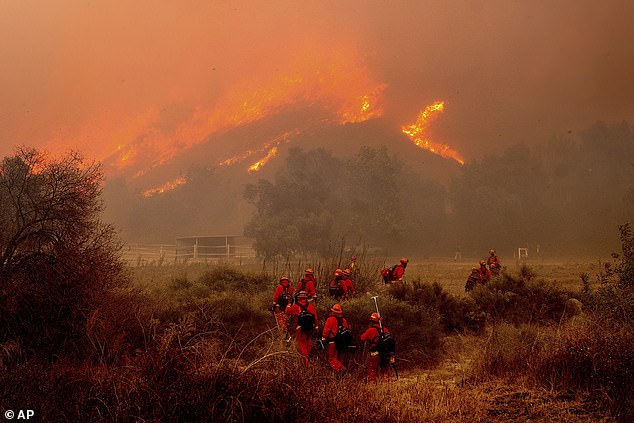How the wave of new forms of dementia could be fueled by a surprising cause linked to climate change
Wildfires were once rare, but as the climate becomes warmer and drier, they are becoming more common and widespread.
Now a study has shown that tens of millions of people are at risk of dementia.
It found that people exposed to wildfire pollution have an 18 percent higher risk of developing any form of dementia after just three years of exposure.
While people exposed to pollution not caused by bushfires – such as that from manufacturing or cars – are only one percent more likely to develop dementia.
Long-term exposure to pollutants known as total particulate matter (PM2.5) is a recognized risk factor for dementia, but less is known about how the small particles of pollution caused by bushfires – ash, carbon monoxide and dioxide, formaldehyde, volatile substances compounds and various other carcinogenic substances affect people’s brains.
Researchers examined the medical records of 1.2 million people exposed to wildfire pollution for an average of three years in California between 2008 and 2019.
According to CAL FIRE, there were 90,157 wildfires during that period, and the study found that approximately 81,000 people were diagnosed with dementia during the study period.
The researchers said their results show that wildfires are even more harmful than the already deadly pollution released by traditional means such as cars and factories.
Flames consume a house as the Mountain Fire burns in Camarillo, California in November 2024

Inmate firefighters battle the mountain fire at Swanhill Farms in Moorpark, California in November 2024
PM2.5 is small enough to enter the lungs through inhalation, and researchers believe the particles then enter the bloodstream and circulate through the body, penetrating the brain’s protective barriers.
This, they concluded, can accelerate brain deterioration and lead to dementia.
PM2.5 is also produced by the combustion of gas, diesel, wood, manufacturing and refineries, as well as by burning candles, although the substances released during forest fires are more harmful, according to the researchers.
The study looked at diagnoses of Alzheimer’s disease, Lewy Body dementia, vascular dementia, frontotemporal dementia, Parkinson’s dementia and unspecified dementia.
An estimated 7 million Americans aged 65 and older had dementia in 2020, and the share of adults aged 70 and older with dementia was 10 percent in 2019.
If current trends continue, more than nine million Americans could suffer from dementia by 2030 and 12 million by 2040, according to the Population Reference Bureau.
But researchers from the University of Pennsylvania and Kaiser Permanente in California, who conducted the latest study, claimed that as wildfires become more common, dementia also becomes more common – and they called for more research into the issue.
They also said more needs to be done to reduce air pollution for particularly vulnerable populations, such as minorities and people living in more impoverished neighborhoods.
The researchers concluded: ‘As the climate changes, interventions aimed at reducing wildfire exposure to PM2.5 could reduce dementia diagnoses and associated disparities.
‘These latest findings underline the importance of research that takes into account the effects of air pollution on potentially vulnerable subgroups of the population and aims to identify potential strategies to reduce disparities in the effects of air pollution exposure.’

An estimated 7 million Americans aged 65 and older had dementia in 2020
Facts University of Maryland researchers calculated that the area burned by wildfires increased by about 5.4 percent per year between 2001 and 2023.
PM2.5 refers to the concentration of microscopic particles in the air that are 2.5 micrometers or smaller. They are measured in micrograms per cubic meter (µg/m³).
These pollutants are small enough to penetrate deep into the lungs when inhaled and circulate throughout the body, including the brain.
The particles can produce highly reactive molecules and free radicals.
Excessive production of these molecules can overwhelm the immune systems of brain cells, leading to cell damage, DNA mutations and impaired cell function.
Excessive production has also been linked to heart disease, cancer and Alzheimer’s disease.
Researchers also say that wildfire PM2.5 may cause the overactivation of certain types of immune cells that help maintain a healthy balance in the brain, fight infections and remove harmful waste from the brain.
Their overactivation can lead to harmful effects on the brain and spinal cord.
Pollution from wildfires can also produce an overwhelming amount of so-called cytotoxic factors – things that damage or kill healthy living cells.
The researchers added that exposure to PM2.5 may indirectly lead to dementia by disrupting the body’s normal processes, which can increase the risk of blood clots, excessive bleeding, brain blood vessel dysfunction and stroke, which may be an underlying could be a risk factor. for dementia.
About two-thirds of study participants were diagnosed with unspecified dementia. The second most commonly diagnosed dementia was Parkinson’s disease at 13 percent, followed by Alzheimer’s disease at 12 percent.
Other analyzes of the data found that study participants under age 75, people from minority groups, and people living in high-poverty areas had “elevated responses” to wildfire PM2.5.
According to the studypublished in JAMA Neurology, the 2018 wildfire season resulted in an estimated $149 billion in healthcare costs, along with capital and economic damage.
